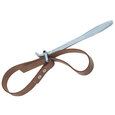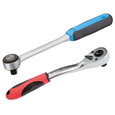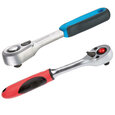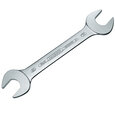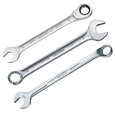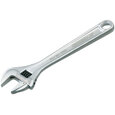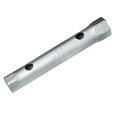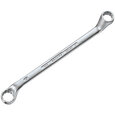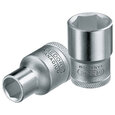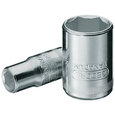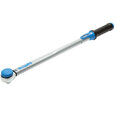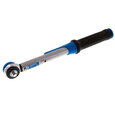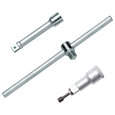Wrench Buying Guide
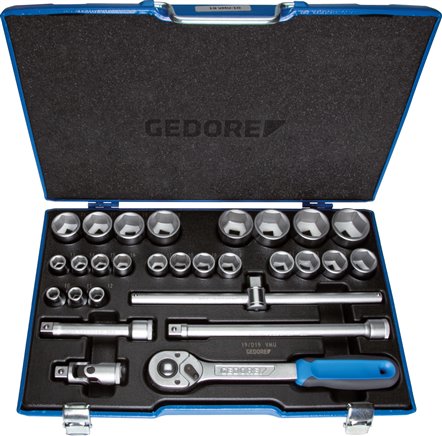
Figure 1: Socket wrench set
A wrench is a tool used to loosen or tighten objects, usually bolts. Choosing the right wrench is important for both DIY and professional jobs. This guide looks at different types of wrenches, from adjustable to torque, and explains their features and uses to help you find the best tool for your needs.
Table of contents
- Wrench types
- Adjustable wrench
- Combination wrench
- Double open-end wrench
- Ratchet wrench
- Box wrench
- Double-end socket wrenches
- Torque wrenches
- Allen wrench
- Torx key
- Strap wrench
- Socket wrench handles and extensions
- Wrenches vs ratchets and sockets
Wrench types
There are male and female wrenches. Male wrenches are inserted much like a screwdriver head. A female wrench, which is what is generally thought of as a normal wrench type, has a socket that sits over the item being turned or around it. In general, the two wrenches are used to loosen or tighten all kinds of nuts, bolts, screws, and even mechanical caps and casings.
Within the broader term of wrenches, there are three distinct types. These are spanners, keys, and sockets:
- Keys: Keys are often specialized items for one particular purpose. They often appear like a key without teeth or a t-shape socket. Examples of keys are Allen keys, bottle openers, and window cranks.
- Spanners: Spanners are wrenches used to turn a spanner head and have a design that has hooks instead of a normal end. In the United Kingdom, the term is used to describe all sorts of wrenches; in the United States, spanners are a subgroup of wrenches.
- Sockets: Socket wrenches can refer to either ratchets, socket wrenches, impact wrenches, and more. However, the principle remains the same, a lever or drive shaft with an attachment such as a socket or impact socket.
Below, you will find various assorted wrenches, their most common use features, and whether they are manufactured for standard, metric, or both. .
Adjustable wrench
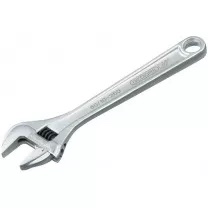
Figure 2: Adjustable wrench
Adjustable wrenches, also known as crescent wrenches, are among the most popular wrenches available. There is an open-end with a spiral screw that turns to open and close the crescent. This allows them to be used on a wide range of fasteners, both small and large. The adjustable wrench can perform similar functions as a set of combination wrenches or wrench wrenches, although they occupy more space because of their thicker size.
- Tightens/loosens nuts and bolts
- Moveable jaw to adjust wrench size
- Works with both standard and metric fasteners
Combination wrench
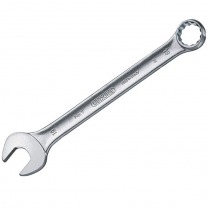
Figure 3: Combination wrench
Combination wrenches have a closed loop on one side (box-end) for hexagonal or square nuts, while the other end is an open U-shape (open-end). These wrenches are often used for nuts that are hard to loosen. The closed-end can loosen the nut, while the open end is then used to unscrew it fully. Combination wrenches are available as single pieces but are usually sold in sets containing a variety of wrench sizes.
- Tightens/loosens nuts and bolts
- Metric and standard sizes
- One open end and one box end (usually the same size)
Double open-end wrench
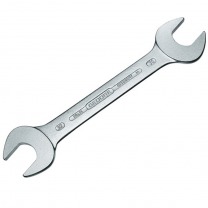
Figure 4: Double open-end wrench
Double open-ended wrenches are one of the most common tools found in a toolbox. The open-ended wrench has two U-shaped ends, that are typically two different sizes. Their open design makes it easy to attach them either horizontally or vertically to a fitting. In contrast to box-ended wrenches, their downside is that these are more prone to rounding off nuts.
- Tightens/loosens nuts and bolts
- Metric and standard sizes
- Two open ends (usually different sizes)
- Jointed or flex-head models let you work at different angles
Ratchet wrench
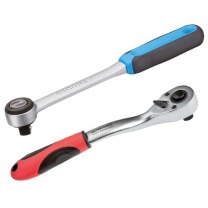
Figure 5: Ratchet wrench
A socket wrench, also called a ratchet, uses a ratchet mechanism to make it quick and easy to tighten or untighten nuts and bolts without picking up or lifting the wrench off the fasteners. This allows for tightening/loosening in smaller confined spaces. A socket wrench typically has a square drive, which connects it to different size sockets. The socket is then sized to the fastener you are working with. Therefore, you only need one socket wrench and then a range of sockets.
- Tightens/loosens nuts and bolts
- Metric and standard sizes
- Ratchet action on one end moves freely in one direction and engages the fastener in the other direction to tighten or loosen nuts and bolts without removing the tool
- Some have pivoting ratchet ends for use in tight spaces
Box wrench
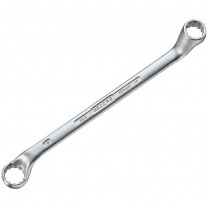
Figure 6: Box wrench
Box wrenches have a closed-loop on both ends, sometimes slightly higher or lower than the handle, which is used to grip recessed nuts without rounding the tips. The closed ends fit either hexagonal or square bolts and are of different diameters. Box-ended wrenches are usually sold in sets.
- Tightens/loosens nuts and bolts in tight spaces
- Metric and standard sizes
- Allow for greater torque control and less accidental slippage off the fastener
Double-end socket wrenches
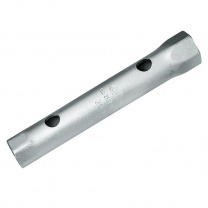
Figure 7: Double-end socket wrench
A double-end socket wrench is designed like a hollow tube that fits around the nut or bolt. It may incorporate a handle, If not it is referred to as a socket and is generally used with varying drive tools to make it a wrench such as a ratchet handle, a tee bar, or a knuckle bar.
- Useful for reaching nuts and bolts in hard to reach vertical places
- Can be operated with two hands, where the user can apply more power
- Metric and standard sizes
Torque wrenches
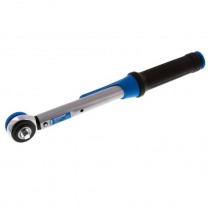
Figure 8: Torque wrench
The torque wrench is engineered to provide a precise amount of torque without overtightening. This amount can be calibrated, and various sorts are available such as manual, digital, and other variations. The torque wrench is frequently used in the automotive trade to tighten nuts and bolts accurately. However, these wrenches are also used on bicycles, agricultural equipment, and any other place where the maker specifies an exact torque specification. This ensures you dont over-tighten a fastener, but that it is tight enough. It either has a gauge to read the torque or it will start to slip at the set torque. A torque wrench typically has a square drive, which connects it to different size sockets. The socket is then sized to the fastener you are working with. Therefore, you only need one torque wrench and then a range of sockets.
- Tighten nuts and bolts
- A torque wrench can be set to a specific amount of torque (rotational force) and indicates when you tighten a fastener to that point
- Helps prevent over-tightening
- Available in a wide variety of torque ranges
Allen wrench
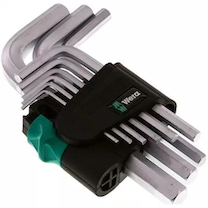
Figure 9: Allen wrench
Due to its hexagonal shape, this male-type wrench is also known as a hex key. The Allen key usually comes in an L-shaped or T-shaped shape and fits into a hexagonal recess in the head of screws and bolts. You can generally get Allen wrenches in either metric or standard.
- Great for tightening or loosening hex-head screws and bolts
- Comes in either standard or metric sizes
- Available individually or in sets
- Available with T-handles for improved leverage
Torx key
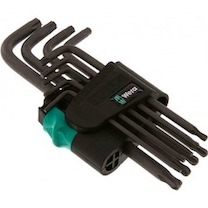
Figure 10: Torx wrench
The Torx key is engineered to fit in the star-shaped recess in bolts and screws. Torx screws and bolts are often preferred due to a higher, more consistent torque level than conventional screw heads. Torx keys are available in a wide variety of shapes, sizes, and for different applications.
- Tightens/loosens six-point, star-head screws and bolts
- Standard and metric sizes
- Available as separate wrenches or in sets where the wrenches fold up into a handle
Strap wrench
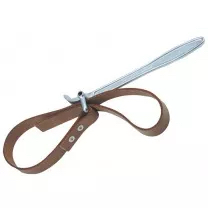
Figure 11: Strap wrench
The strap wrench is a wrench that holds objects by tightening straps. They prevent objects from slipping by using friction. Most strap wrenches come with handles so that you have a firm grip while using the wrench. If they dont have a handle, it is designed to be used with the square drive found on ratchet wrenches. Since rubber belts are used in strap wrenches, whatever you are working with is unlikely to suffer damage or wear. Read our strap wrenches overview article for more information.
- Strap wrenches wont scratch delicate surfaces
- Adapts to any size necessary
- Can also be used for household tasks like opening jars
Socket wrench handles and extensions
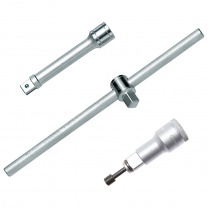
Figure 12: Wrench handle and extension
Whether you are a professional mechanic, or an avid amateur builder, having a ratchet only gets you so far. The interchangeable design of a ratchet, torque wrench, or socket wrench means you can handle many tasks with different sockets and attachments. Some of the more important handles and extensions are below.
- Cardan joint adapter: An attachment that connects the ratchet to a socket, allowing you to angle the ratchet in relation to the fastener. It allows you to turn fasteners in places where a standard ratchet/socket combination would not have clearance to swing back and forth.
- Socket/ratchet extension bar: Connects a socket to a ratchet to extend the sockets reach and turn recessed fasteners.
- Sliding bar handle: The sliding bar handle provides extra reach, access around obstructions, and the ability to apply more torque.
Wrenches vs ratchets and sockets
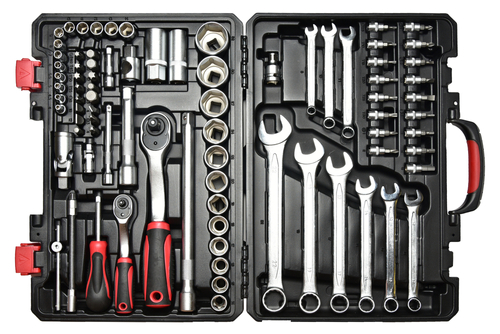
Figure 13: Selection of wrenches, ratchets, and sockets
Wrenches fasten and undo fasteners in the same way as ratchets and sockets, but there are circumstances in which one tends to be used over the other. Using a box-end wrench is a good option for loosening fasteners that are stuck; these allow you to apply more torque without damaging the mechanism. The open-end wrench fits around the fastener, rather than covering it, which is why you can use it in places where there is no room for a socket.
Ratchet and socket combinations (sometimes called socket wrenches) permit you to turn a fastener without repositioning the tool. This will be especially helpful when there is not enough space to turn a wrench in a full circle. A socket offers a safer solution than a standard open-end wrench since it fully surrounds the fastener and is less likely to slip off the fastener.




